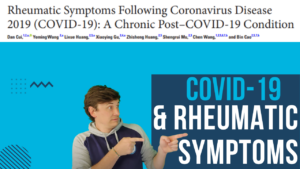Naturally as Polymyalgia Rheumatica had some exposure over social media, Giant Cell Arteritis came to the surface as well. In this blog we will go over the BSR guidance for this condition and hopefully lend some understanding to clinicians who may come across it in clinic.
The new recurring features are back too “Legend of the Blog” and if you scroll all the way to the bottom you can listen to the music I was listening to when I wrote this.
Please consider heading to the shop to find more resources and supporting me to continue this hairbrained project! You can also listen to all of my blogs as podcasts subscribe to your preferred channel HERE
As usual feedback is greatly appreciated and any further reading for me please send it my way!
PLEASE REMEMBER – THIS BLOG IS NOT A REPLACEMENT FOR CLINICAL REASONING, IF YOU ARE UNSURE GET ADVICE
Legend of the Blog
This weeks legend is Claire Paling who has written some amazing Tweet threads on blood testing which are 100% worth checking out Thread 1 – Thread 2 – Thread 3. Please be sure to follow Claire on twitter after clicking on one of those links!
Introduction
Giant Cell Arteritis (GCA) is relatively rare but incidence is increasing secondary to ageing populations. There are significant overlaps with Polymyalgia Rheumatica (PMR) and while GCA is not going to be a common occurrence in Musculoskeletal or First Contact Practitioner (FCP) clinics it will require ruling out in PMR cases.
GCA is a subset of Vasculitis and involves the large and medium blood vessels such as the aortic and temporal arteries. It is a medical emergency and ideally requires specialist evaluation on the same day as presenting to the practitioner.
The BSR guidance published this year is excellent and provides loads of depth, I have mostly summarised it in this blog for a Physiotherapist (MSK Practitioner) viewpoint.
Presentation
GCA is extremely rare under the age of 50 and peak onset occurs between 70-79 years of age. I have so far been unable to find a prevalence for Men:Women but PMR is more prevalent in Women so expect to be assessing more females for the condition than men.
Symptomatic presentation is heterogenous and vigilance is key, we are looking for symptoms that are possibly caused by inflammation of the blood vessels. These include:
- Jaw and/or limb claudication
- Headache or Scalp tenderness (this is commonly present for 3 months before seeking help)
- Visual Loss or double vision
- Fever and/or weight loss
- Polymyalgic Syndrome
Features which may indicate an alternative diagnosis is more likely include:
- Neurological deficits
- Very severe constitutional symptoms
- Local signs of Ear/Nose/Throat issues
Assessment
If GCA enters your differential diagnosis then further assessment can be helpful. It is worth noting that the presence of the findings are not diagnostic, nor is the absence definitive.
Palpate the Temporal arteries (this tweet from Alan Taylor is helpful https://twitter.com/TaylorAlanJ/status/1335525380044754944?s=20 ) to look for the following:
- Tenderness
- Absent pulsation
- Erythema
- Swelling
You can also gently palpate the scalp above the temples assessing for tenderness, other signs of scalp tenderness are pain with hair brushing and inability to wear a hat.
Blood pressure readings may be different in both arms if the peripheral vessels are involved.
Assess for Polymyalgic Syndrome a masquerade of Polymyalgia Rheumatica (Full PMR detail here)
Bloods
If suspicious we are not going to be requesting bloods however it is worth noting that if recent blood results are available (testing for PMR for example) then a normal ESR makes GCA much less likely. CRP may be raised and in the FBC, Platelets may be raised.
Investigation
Current gold standard is a temporal artery biopsy, this can be supplemented with ultrasound imaging of the temporal arteries and axillary arteries. Some people reading this blog will have point of care ultrasound and will be able to utilise this. It is outside of the scope of this blog to discuss that and I suggest specific training is required.
Onward Referral
As mentioned GCA is a medical emergency and requires assessment by a specialist ideally on the same day but all patients should be seen within 3 days. This will usually be a Rheumatologist but in cases of visual loss an Ophthalmologist is also necessary. Please look locally at the specific pathways for GCA, while some locations may have specific rapid access this will mostly be via the A&E department.
Practicalities
As mentioned at the start, GCA is a relatively rare condition. I expect the likely clinical reasoning process in most cases to be one of suspecting PMR, Fibromyalgia or other similarly presenting conditions in patients over 50 and ensuring ruling out of this condition. Ensuring asking about headaches, claudication and visual loss is a necessary component for the history taking.
I would also advocate for having an available colleague to discuss these types of cases and ensuring you have been in touch with the local Rheumatology Department to understand the pathway.
End
I am not sure GCA is on everone’s differential diagnosis list and it is a clinically important diagnosis even though relatively rare. I hope this has been useful to understand its place.
Get me any feedback you might have so that I can grow and improve.
See you next time!
Music Choice: Enter Shikari – “Satellites”
“All my limbs, they ache inside
And surely all my family and my friends
My god and my ends
They cannot all be wrong
So I play along”
References
Sarah L. Mackie et al, British Society for Rheumatology guideline on diagnosis and treatment of giant cell arteritis, Rheumatology, Volume 59, Issue 3, March 2020, Pages e1–e23, https://doi.org/10.1093/rheumatology/kez672
Smetana GW, Shmerling RH. Does this patient have temporal arteritis? JAMA. 2002 Jan 2;287(1):92-101. doi: 10.1001/jama.287.1.92. PMID: 11754714.


